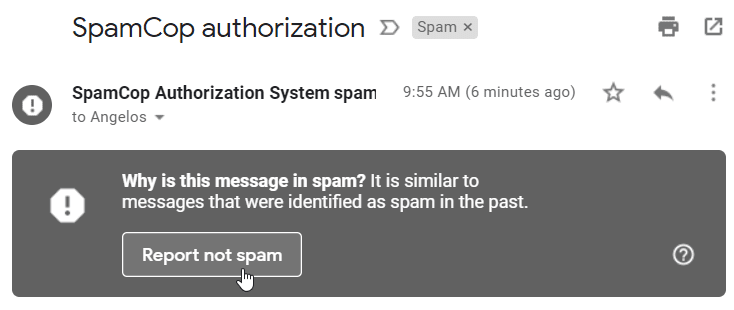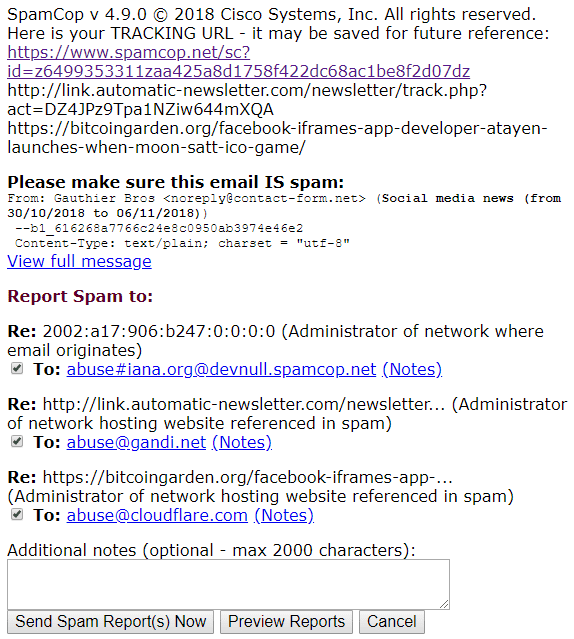Junkmail is far from a minor annoyance. More than 100 billion spam email messages are sent each and day, and the annual cost to fight spam was more than 20 billion dollars... in 2012. Most of us get at least one spam email on a daily basis. We might even be getting tens or hundreds of them, if we were careless with our email address. We can take part in this war, and properly report junkmail, to improve email for everyone.
Unblock any international website, browse anonymously, and download movies and Mp3 with complete safety with CyberGhost, just for $2.75 per month:
First of all: Not every unwanted email is junkmail
Before we report a message, we must make sure that it is actually a spam email. You might be thinking "Well, I know junkmail when I see it". However, it is not as straightforward.
Let's say we created an online account of any type, and the website or service had pre-checked a "subscribe to our newsletter" checkbox.

If we get a sales message from this particular website, this is not a spam email.
Let's repeat, for emphasis: this is not junkmail.
The site or service gave us a clear choice to not subscribe to the newsletter, just by unchecking the checkbox. We either didn't see it, or we saw it and ignored it. In both cases, we gave them every legal and ethical right to email us, even if by omission.
The same goes for newsletters that we willingly and knowingly subscribed to. A newsletter can turn out less than interesting, or we might be getting too many emails from them. It doesn't make it junkmail if we subscribed to it in the first place.
In these situations, the best course of action is to automatically unsubscribe from the newsletter, using the link we will usually find at the bottom. Every legitimate email service is required by law in most countries to have an automatic unsubscribe feature.

True junkmail consists of emails that we never signed up for. They might include some type of scam, or they might offer a legitimate service (of course, it's a scam more often than not). Either way, since we never agreed to receive those emails, they are junkmail.
It's not unusual for such a spam email to include a supposed unsubscribe link.

On an actual spam email, we should never, ever click on the unsubscribe links. Since we never subscribed to the service, clicking unsubscribe will only prove to the particular spammer that our email address is active, and we will start receiving more junkmail.
Even some legitimate newsletters can have spammy behavior, in cases when the unsubscribe button fails to remove us automatically from the list.
These are the emails we must report as junkmail to the proper authorities.
Isn't it enough to click "Report spam" on my webmail?
If our webmail, be it Gmail, Outlook.com, Yahoo, or any other, has already identified an email as spam, why should we go the extra mile? For any messages that slip through the cracks, we click on "report spam," and that's it. Right?

Well, that is what everyone is doing already. Has it stopped spam? No, it hasn't. Is it enough to stop spam in the future? No, it isn't.
If we want to get serious about getting rid of junkmail, we need to get mad. Well, not necessarily. But we do need to report spam properly. If more users did it, it would make a significant difference.
How to use SpamCop to report unwanted email
SpamCop belongs to Cisco, and it is one of the best-known junkmail reporting services.
To use the service, we must first sign up. We enter a display name or alias and a valid email address where spamcop.net can contact us, should they have questions or problems with our report. It is a safe bet that SpamCop won't send us any junkmail.

SpamCop will send us an authorization email. In a twist of irony, SpamCop's email went straight to our junkmail folder, do not pass Go, do not collect $200.

Are the 686 unread emails triggering you? Well, tough luck!
This has actually happened to us in the past, on a previous version of this guide, and with the old look for Gmail. 0 for 2 so far for SpamCop.

After we click the "Report not spam," as we should for every legitimate email that mistakenly ends up in the junkmail folder...

...we get a random password to use with SpamCop.

After we log in, we can report spam by forwarding it as an attachment to our personalized email address...

...or copy and paste the entire junkmail code at the form, either by showing the full headers on our email client, or clicking "Show original" in Gmail. We then click on the "Process Spam" button.

SpamCop won't accept spam reports for emails over 50000 bytes (48.8KB) and will ask us to truncate the message.

If we don't have a paid SpamCop subscription, which costs $15 yearly, we need to wait for about six seconds for the spam email processing. For most users, the free tier is more than enough, but it comes in handy for hardened junkmail warriors.

Also, we can only report spam which is relatively "fresh." SpamCop won't accept messages more than two days old.

If we did everything right, SpamCop will announce the proper authorities to send the report. The service will automatically send the spam report or reports on our behalf, with a click of the relevant button.

Those reports change, depending on the particular spam email. They include the spammer's mail server administrators, their ISP, and any websites advertised within the spam.

Whitelist our mailhosts
SpamCop also has an optional "Mailhosts" configuration option, where we can include our personal email address. This is to avoid having it characterized as junkmail by mistake when we report spam. It will also help resolve mail header forgeries.

On the bottom of the page, we click on the "Add first hosts" link.

After we read the contents of the page carefully, we select "Yes" if we understand and agree, and then add our email address and a name for the email provider.

On the next step, we check all the mailservers. We will receive one email for each mailserver.

In a few seconds, we will get those account configuration emails. For some reason, in our example, we got three of them in the Primary Gmail tab, and two in the Updates tab. None in the junkmail folder, though, so it is a definite improvement.

We click on the https://www.spamcop.net/mcgi?action=mhreturn link...

...and proceed to enter the full email code, including headers and body.

We repeat this process for all the emails for the different mail servers. Tedious, we know, but it's for a good cause. We can consider fighting junkmail as the "good fight" of our times.
We should do this for all the email addresses where we get junkmail, going to Mailhosts and adding new hosts.

Will you report spam mail?
On a past guide, we showed a way to never see spam, at least from frequent spammers. If we report unwanted and unsolicited email, however, we can help to shut down their awful practices.
Will you use SpamCop? Or do you think it is in vain, and we can never truly beat junkmail? Let us know in the comments below.
Support PCsteps
Do you want to support PCsteps, so we can post high quality articles throughout the week?
You can like our Facebook page, share this post with your friends, and select our affiliate links for your purchases on Amazon.com or Newegg.
If you prefer your purchases from China, we are affiliated with the largest international e-shops:





Leave a Reply